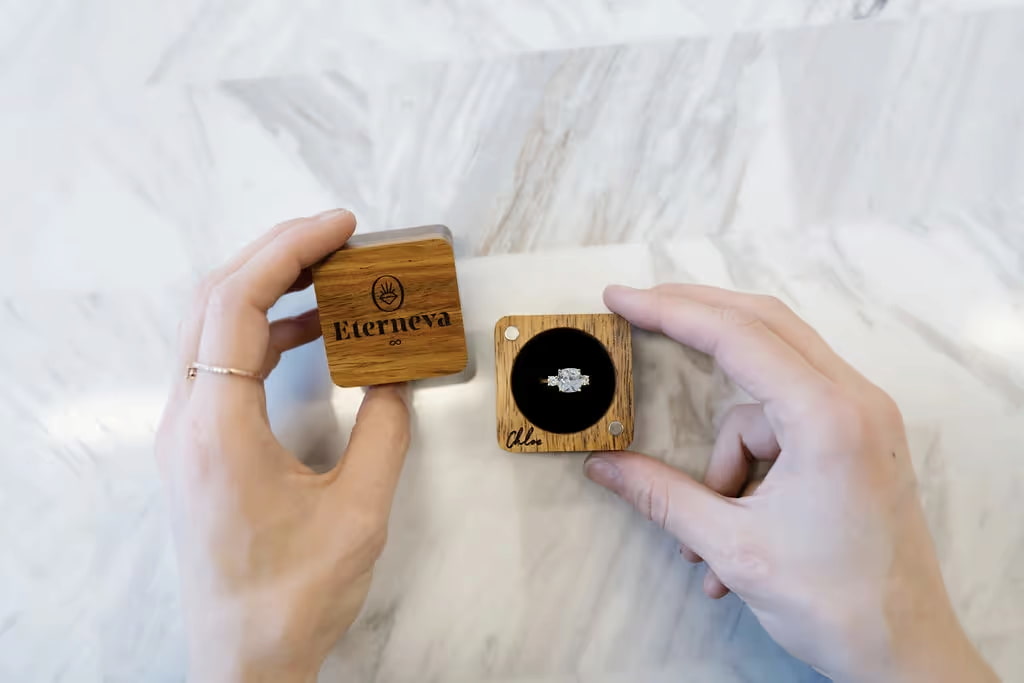How Much Ashes Does It Take to Make a Diamond?
Memorial diamonds are grown using cremated ashes, but it is the element contained in those ashes that makes the diamond possible–carbon. Carbon is the most important component in the memorial diamond creation process. Scientifically, it is the very essence of the loved one that will live on as a physical part of the diamond itself.

Carbon is an essential building block of life. Carbon atoms are constantly moving through all living organisms, the oceans, the atmosphere, and the Earth's crust in what is known as the carbon cycle. Like all living things, human beings are carbon-based lifeforms. We consist of 18.5% carbon, and even when we die and are cremated into ash, some of that carbon survives the cremation process and continues to exist in the ashes that are left behind. Carbon is then extracted from cremated ashes, purified, and used to grow the cremation diamond into a brilliant and beautiful keepsake.
The Carbon Left Behind After Cremation
The human body is comprised of four main elements: Oxygen (65%), Carbon (18.5%), Hydrogen (9.5%), and Nitrogen (3.2%). Carbon is crucial in forming DNA and is found in various bonded compounds throughout our bodies. In other words, it is a foundational element of the deepest and most unique parts of our biology.
Before we get into details, it's important to understand that the exact amount of carbon recovered from cremation ashes can vary greatly and depends on a variety of factors. The precise cremation process, the initial mass and body weight of the individual, and the presence of other materials (such as the casket) can all influence how much ash is left. During cremation, bodies are subjected to high temperatures (1,400°F to 1,800°F) that transform some solid matter into gases like carbon dioxide.

After cremation, bone and base elements, including calcium carbonate, remain in the form of ash. Although carbon levels are reduced from 18.5% to roughly 1-4% through the output of carbon dioxide during the process, a significant amount of carbon persists post-cremation. A single cremation typically produces around 2-3 kg of cremated ashes. From that amount, you can expect to extract somewhere between 20 and 120 grams of carbon. With just 1 gram of carbon required to grow a diamond, only a half cup of ashes is necessary to facilitate the process. This leaves plenty of ashes left over for scattering, burying, keeping in an urn, or anything else you wish to do with the ashes of the deceased.
Extracting the Carbon to Make a Diamond
Lab-grown diamond creation requires high-purity carbon, which is typically sourced from graphite. However, using precise scientific processes, the carbon from cremated ashes can be purified and converted to graphite, which can then be used to grow a beautiful diamond for memorial jewelry. All from just a half cup of ashes! Here’s how the process works:
· Carbon Extraction. The ashes are processed to extract the carbon. This involves heating and chemical treatments to remove non-carbon elements.
· Carbon Purification. The carbon is then purified. This is a crucial step, as any impurities can affect the quality and clarity of the lab-grown diamond. This process involves heating the carbon to very high temperatures to burn off impurities.
· Conversion to Graphite. The purified carbon is then converted into graphite. This is done by again subjecting the carbon to high temperatures and pressures over a period of weeks. The resulting graphite is 99.995% pure carbon and is now ready for the diamond-making process.
· Diamond Growth. The graphite is placed in a High-Pressure High Temperature (HPHT) machine or Chemical Vapor Deposition (CVD) reactor, where it is subjected to conditions similar to those that occur deep within the Earth where natural diamonds form. In the HPHT machine, the graphite is put under extreme pressure and temperature until it converts into a diamond. In the CVD process, a diamond seed is placed in a chamber, and the chamber is filled with a carbon-containing gas that is heated until it breaks down, allowing the carbon atoms to adhere to the diamond seed and grow the diamond from it.
· Cutting and Polishing. Once the diamond has been created, it's cut into the desired shape and polished using the same tools, processes, and expertise as mined diamonds.
How Much of My Loved One’s Carbon is in My Diamond?
Eterneva’s memorial diamonds use a mix of personal carbon extracted from the cremains of the deceased person and generic carbon from other sources. Both the personal carbon and the generic carbon undergo the same HPHT process described above to ensure the samples are pure.

Personal carbon usually makes up 10-15% of the carbon used to create the diamond. By introducing additional generic carbon, the HPHT process is able to grow a larger, higher carat, better quality diamond while still encompassing the essence of your loved one.
Carbon is one of the most fundamental elements in our universe. It can be found everywhere, from the stars, light years away in space, to the cells in individual strands of DNA that make us who we are. It is the perfect representation of the connectedness of everything and the cyclical nature of life itself. When you create a diamond from the carbon of a loved one, you are taking a part of them with you into the next stage of life’s journey.













